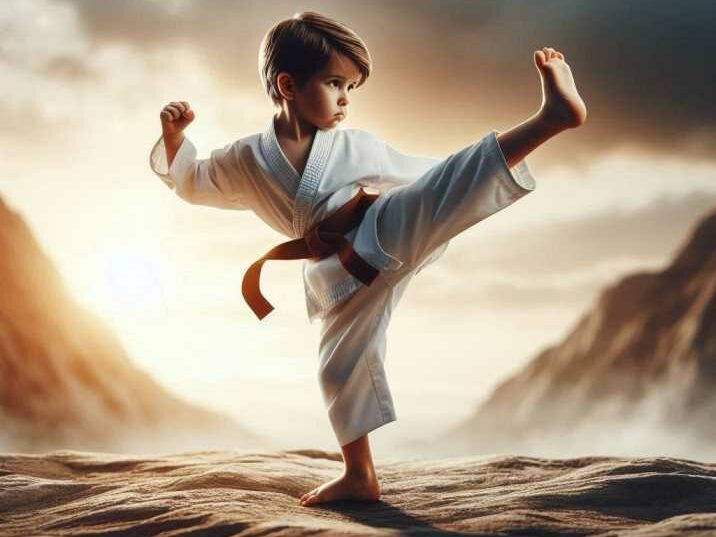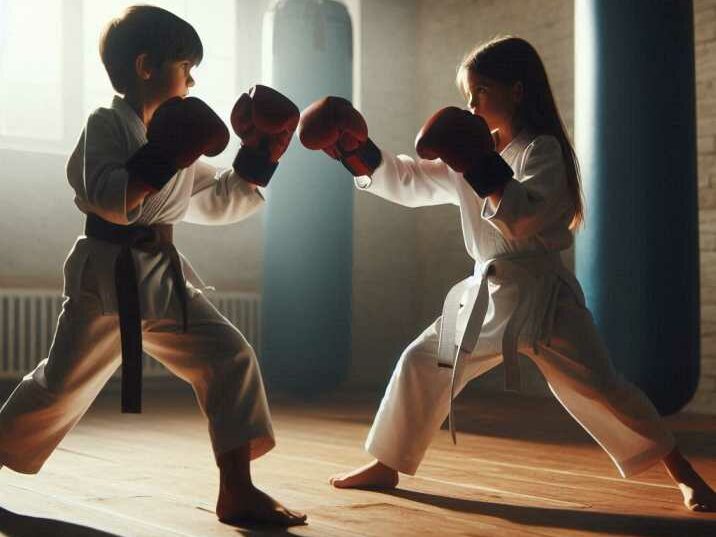Introduction
Table of Contents
As parents, we all want the best for our children, especially when it comes to their physical and mental development. One common concern many parents have is about their child’s clumsiness. If you’ve been wondering, “Will martial arts help my child with clumsiness?” you’re in the right place. This article will explore various aspects of how martial arts can be a beneficial practice for children who struggle with coordination and balance.

Table of Contents
- Understanding Clumsiness in Children
- The Benefits of Martial Arts for Physical Development
- Improving Coordination and Balance
- Building Confidence and Discipline
- Social Benefits of Martial Arts
- Choosing the Right Martial Art for Your Child
- Tips for Parents
- Detailed Explanation of Martial Arts Techniques
- Case Studies and Testimonials
- Scientific Research and Studies
- Martial Arts and Cognitive Development
- Comparing Different Martial Arts
- Parental Involvement and Support
- Safety Precautions and Injury Prevention
- Integrating Martial Arts with Other Activities
- Frequently Asked Questions
Understanding Clumsiness in Children
Clumsiness in children is often characterized by awkward or uncoordinated movements. It can result from various factors, including developmental delays, lack of physical activity, or even genetic predispositions. While clumsiness is usually just a phase, it can sometimes lead to low self-esteem and social challenges.
Children who are clumsy might frequently trip, bump into things, or have difficulty with tasks that require fine motor skills. It’s essential to understand that this is a common issue and, in many cases, can be improved with the right activities and exercises.
The Benefits of Martial Arts for Physical Development
Martial arts, such as karate, taekwondo, and judo, offer a structured environment where children can enhance their physical abilities. These disciplines focus on improving strength, flexibility, and overall fitness, which are crucial for overcoming clumsiness.
Key Benefits:
- Strength Training: Martial arts involve various exercises that build muscle strength, which helps in controlling movements more effectively.
- Flexibility: Regular stretching exercises improve flexibility, reducing the risk of injuries and enhancing the child’s ability to perform smooth and coordinated movements.
- Endurance: Martial arts training includes aerobic activities that boost cardiovascular health and stamina, helping children to maintain energy levels throughout the day.
Improving Coordination and Balance
One of the main goals of martial arts is to develop precise movements and control. This directly addresses issues of coordination and balance, which are often the root causes of clumsiness in children.
Key Techniques:
- Repetitive Drills: These drills help in ingraining motor skills through muscle memory, making movements more automatic and less awkward.
- Balance Exercises: Many martial arts moves require balancing on one leg or shifting weight smoothly, which enhances the child’s ability to maintain stability.
- Focus and Awareness: Martial arts teach children to be mindful of their body movements and spatial orientation, reducing the frequency of clumsy mishaps.
Building Confidence and Discipline
Clumsiness can sometimes affect a child’s self-confidence. Martial arts foster an environment of respect, discipline, and personal achievement, which can significantly boost a child’s self-esteem.
Key Benefits:
- Goal Setting: Achieving belts or mastering new techniques provides a sense of accomplishment.
- Positive Reinforcement: Instructors often use positive reinforcement to encourage progress, which helps build confidence.
- Discipline and Respect: The structured environment of martial arts classes instills discipline and respect, which can translate into other areas of life, including academic performance and social interactions.
Social Benefits of Martial Arts
Participating in martial arts can also offer social benefits that help children overcome the social challenges associated with clumsiness.
Key Benefits:
- Teamwork and Friendship: Martial arts classes often involve partner exercises and group activities, fostering a sense of camaraderie.
- Social Skills: Interacting with peers in a structured setting helps improve communication and social skills.
- Sense of Belonging: Being part of a martial arts community can provide a supportive network, making children feel included and accepted.
Choosing the Right Martial Art for Your Child
Not all martial arts are the same, and choosing the right one for your child can make a significant difference. Here are some popular options and their specific benefits:
- Karate: Focuses on striking techniques, which are great for improving hand-eye coordination and quick reflexes.
- Taekwondo: Known for its dynamic kicking techniques, it helps enhance leg strength and balance.
- Judo: Emphasizes throws and grappling, which can improve overall body coordination and strength.
- Aikido: Focuses on fluid movements and harmony, which can be beneficial for overall balance and flexibility.
Tips for Parents
Here are some tips to help you support your child as they embark on their martial arts journey:
- Be Patient: Improvement in coordination and balance takes time. Celebrate small achievements along the way.
- Encourage Practice: Regular practice at home can reinforce what is learned in class.
- Choose a Good Instructor: A supportive and skilled instructor can make a significant difference in your child’s progress.
- Ensure Proper Gear: Proper attire and safety gear are essential to prevent injuries and ensure a positive experience.
Detailed Explanation of Martial Arts Techniques
Martial arts encompass a variety of techniques that can specifically aid in improving a child’s coordination and balance. Here are some examples:
Karate Techniques:
- Punching Drills: These drills help in developing hand-eye coordination.
- Kicking Combinations: These exercises enhance leg strength and stability.
Taekwondo Techniques:
- High Kicks: Focus on balance and flexibility.
- Spin Kicks: Improve spatial awareness and body control.
Judo Techniques:
- Throws: Teach how to control body weight and balance.
- Falls and Rolls: Essential for learning how to move gracefully and safely.

Case Studies and Testimonials
Real-life examples can be powerful in illustrating the benefits of martial arts. Here are a few case studies and testimonials:
Case Study 1: John’s Story – John, a 7-year-old with a history of clumsiness, improved his coordination significantly after six months of karate classes. His parents noticed fewer falls and a boost in his confidence.
Testimonial: Sarah, a Parent – “Martial arts have transformed my daughter’s life. She used to be very clumsy and insecure. Now, she’s more confident and moves with grace.”
Scientific Research and Studies
Numerous studies support the benefits of martial arts for children. For example, a study published in the Journal of Pediatric Exercise Science found that children who practiced martial arts showed significant improvements in balance and coordination compared to those who did not.
Martial Arts and Cognitive Development
Martial arts training is not just about physical development; it also promotes cognitive growth. Children learn to focus, memorize techniques, and solve problems during their training. This cognitive engagement can help in academic performance and everyday decision-making.
Comparing Different Martial Arts
Each martial art offers unique benefits. Here is a comparison to help you choose the best fit for your child:
- Karate vs. Taekwondo: Karate focuses more on hand techniques, while Taekwondo emphasizes kicks.
- Judo vs. Aikido: Judo is more physical with its throws, whereas Aikido is about fluid movements and self-defense.
Parental Involvement and Support
Parental support is crucial in a child’s martial arts journey. Here are some tips:
- Attend Classes Together: Some schools offer parent-child classes.
- Practice at Home: Encourage regular practice of techniques learned in class.
- Stay Positive: Celebrate progress and provide encouragement.
Safety Precautions and Injury Prevention
Safety is paramount in martial arts. Ensure your child uses proper gear and follows the instructor’s guidelines to minimize the risk of injury. Common safety measures include:
- Wearing Protective Gear: Helmets, gloves, and pads.
- Proper Warm-Up: To prevent muscle strains and injuries.
- Supervised Training: Always practice under the supervision of a qualified instructor.
Integrating Martial Arts with Other Activities
Martial arts can complement other sports and activities. For example, the balance learned in martial arts can improve performance in soccer, and the discipline can help in academic pursuits. Encouraging a balanced lifestyle with various activities can lead to well-rounded development.
Conclusion:
In conclusion, if you’ve been wondering, “Will martial arts help my child with clumsiness?” the answer is a resounding yes. Martial arts offer a comprehensive approach to improving physical coordination, building confidence, and fostering social skills. By choosing the right martial art and supporting your child’s journey, you can help them overcome clumsiness and thrive both physically and mentally.
Frequently Asked Questions
Q1: At what age can my child start martial arts?
A1: Most martial arts schools accept children as young as 4-5 years old. However, it’s essential to choose a program that is age-appropriate.
Q2: How often should my child practice martial arts?
A2: Ideally, children should attend classes 2-3 times a week. Regular practice is crucial for improvement but avoid overloading them.
Q3: Can martial arts help with academic performance?
A3: Yes, the discipline and focus learned in martial arts can translate to better concentration and performance in school.
Q4: What if my child doesn’t like martial arts?
A4: It’s essential to find a style and school that your child enjoys. If they don’t like one form, try another before deciding to quit.
Q5: Is martial arts safe for clumsy children?
A5: With proper supervision and the right safety measures, martial arts are generally safe and can actually help reduce clumsiness by improving coordination and balance.
Q6: How long does it take to see improvement in my child’s coordination?
A6: The time it takes to see improvement can vary depending on the child’s dedication and frequency of practice. Generally, noticeable improvements can be seen within a few months of regular training.


